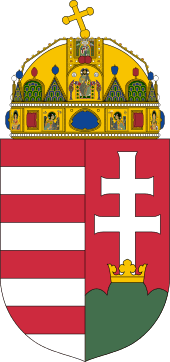Town with county rights
A town with county rights (or urban county, Hungarian: megyei jogú város) is a level of administrative subdivision in Hungary which can be considered as a city in some English-speaking countries. All county seats and localities with more than 50,000 inhabitants are given this status by the Hungarian Parliament and the President. On the other hand, this title cannot be taken back by any law so towns like Hódmezővásárhely or Dunaújváros that are neither county seat nor inhabited by more than 50,000 people are still megyei jogú város. Since 2006, there are 23 towns with county rights.[1] Before 1950, the former so-called towns with municipal rights (törvényhatósági jogú város) had a similar status as the present urban counties.
Budapest is not considered as an urban county and has a special status among the other Hungarian towns.
Every town with county rights is allowed to be subdivised into sectors. The representative body is the General Meeting (közgyűlés) which elects with the County Assembly a council that takes care of different tasks related to the county.[2]
History
Between 1954 and 1971, the four largest regional cities received the megyei jogú város title. These were Debrecen, Miskolc, Pécs and Szeged. Then, from 1971 to 1990, the four precedent cities and Győr had a new status called county town (megyei város) which was given in 1989 to three other towns: Salgótarján, Nyíregyháza and Kecskemét. After the end of Communism, this status was deleted and replaced by the urban counties as until 1971. The eight megyei város and twelve more towns became megyei jogú város.
List
| Coats of arms | City | County | Population (2013) | Urban county since |
|---|---|---|---|---|
 | Békéscsaba | | 61 046 | 1990 |
 | Debrecen | | 204 333 | 1990 |
 | Dunaújváros | | 46 813 | 1990 |
 | Eger | | 54 867 | 1990 |
 | Érd | | 63 333 | 2006 |
 | Győr | | 128 567 | 1990 |
 | Hódmezővásárhely | | 45 700 | 1990 |
 | Kaposvár | | 65 337 | 1990 |
 | Kecskemét | | 111 863 | 1990 |
 | Miskolc | | 162 905 | 1990 |
 | Nagykanizsa | | 49 070 | 1990 |
 | Nyíregyháza | | 118 185 | 1990 |
 | Pécs | | 147 719 | 1990 |
 | Salgótarján | | 37 199 | 1994 |
 | Sopron | | 60 528 | 1990 |
 | Szeged | | 161 837 | 1990 |
 | Szekszárd | | 33 599 | 1994 |
 | Székesfehérvár | | 99 247 | 1990 |
 | Szolnok | | 73 193 | 1990 |
 | Szombathely | | 77 547 | 1990 |
 | Tatabánya | | 67 406 | 1990 |
 | Veszprém | | 60 876 | 1990 |
 | Zalaegerszeg | | 59 618 | 1990 |
References
- ↑ "Towns with county rights – Central Bureau of Statistics" (PDF). ksh.hu. Retrieved 19 June 2014.
- ↑ "2011/CLXXXIX. Legislation about the Local Councils in Hungary". njt.hu. Retrieved 19 June 2014.
